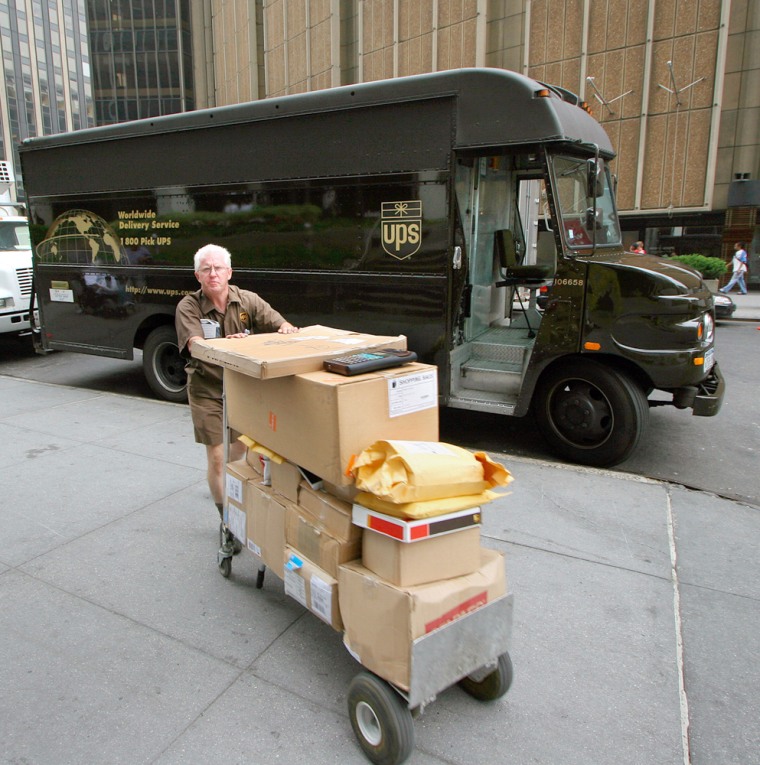After 19 years, Arturo Carrasco is still considered one of the new guys at United Parcel Service Inc.
“I have one of the hardest routes in downtown Chicago and I will have to wait years to be senior enough for one of the easier routes,” said the 40-year-old driver, who came here from Mexico 23 years ago.
The familiar brown-uniformed UPS driver is part of a shrinking class of unionized “blue-collar” jobs that still provide a good income and benefits such as health care, a pension, stock options and long vacations.
As U.S. manufacturers and service companies continue to outsource thousands of jobs to India, China and other countries, solid middle-class positions like Carrasco’s have become even more appealing.
And drivers at UPS -- or “Brown” as many people know it --are more inclined than ever to stay there.
“This is a very good job,” said industry analyst Art Hatfield of investment bank and brokerage Morgan Keegan. “It has all the kind of benefits associated with the U.S. manufacturing sector 20 years ago.”
In 2005, only 12.5 percent of U.S. workers were union members, down from 20.1 percent in 1983, according to the Bureau of Labor Statistics. In the private sector, only 7.8 percent were unionized last year.
UPS has 86,000 U.S. drivers, all represented by one of the country’s largest unions, the International Brotherhood of Teamsters -- unlike the drivers of the Atlanta company’s main rival, FedEx Corp.
FedEx does not disclose salaries of drivers at its express delivery unit, while those at its ground service are contractors.
But UPS officials say its drivers get extra bang for their union dues.
The average UPS driver’s annual salary of $55,000 can rise to $70,000 with overtime. A driver like Carrasco, with more than 15 years on the job earns five weeks vacation, in addition to paid sick days and holidays.
But Carrasco said he valued his health benefits more.
In 2004, his 2-year-old daughter had acute appendicitis and was hospitalized for nearly two weeks. He received a copy of the bill for $50,000, which UPS paid.
“If I had to pay that, it would have broken me,” he said.
Such compensations are part of the reason the average UPS driver has been with the company 15 years. Many of Carrasco’s colleagues have been there twice that long, he said.
The allure of 'Brown'
Besides the union benefits, the job of UPS driver offers a special kind of security.
“It is no surprise that people want to stay in jobs like this because they cannot be exported or outsourced,” said Cathy Minkler, a researcher at Washington analytical firm Bureau of National Affairs Inc.
Organized labor has seen pay, benefits, pensions and even the jobs themselves diminish at union strongholds like General Motors Corp., Ford Motor Co. and bankrupt airlines, in contrast to UPS.
Some jobs in nursing and retail sales have also become more appealing because they cannot be done overseas.
“These are the jobs that stay and are becoming more attractive as manufacturing jobs go abroad,” Minkler said.
But attractive does not mean easy, Carrasco said. All day long he delivers heavy boxes that usually contain computers, printers, monitors or heating equipment -- and that often are marked: “Made in China.”
But he said the UPS driver is also a salesman, combining blue-collar manual labor with white-collar duties.
UPS set up an incentive program in 1991 to encourage drivers to win accounts through personal service. It has been a hit, bringing in an average of 60 million new packages a year since then, company spokesman Dan McMakin said.
One of Carrasco’s customers, the National Restaurant Association Educational Foundation, once used FedEx. For two years, he said, he did a little extra for the foundation every day until UPS got the account in July 2003.
“They ship hundreds of packages every day, so it’s a big account,” said Carrasco, who got a $500 bonus for his efforts.
UPS Chief Executive Mike Eskew said that a combination of good salaries and benefits, which encourage drivers to remain on the job for decades, and the sales approach provide UPS with a competitive advantage.
“Our approach encourages loyalty, and these drivers go out and perform a role that is valued by communities across the United States,” Eskew said. “We think that’s a unique model.”
This has not always worked to UPS’ advantage. In 1997, drivers staged a two-week strike when contract renewal negotiations collapsed, costing the company $750 million.
UPS is currently negotiating a new contract with its unionized pilots, who have sought to be released from talks overseen by the National Mediation Board. That request was declined late December.
“We are confident that we will successfully conclude talks on a new contract soon,” Eskew said.
